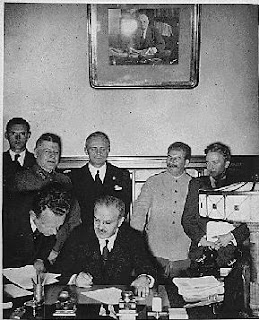 The Ribbentrop-Molotov Pact, colloquially named after German foreign minister Joachim von Ribbentrop and Soviet foreign minister Vyacheslav Molotov, refers to the officially-titled Treaty of Non-aggression between Germany and the Union of Soviet Socialist Republics, signed in Moscow in the early hours of August 23, 1938, dated August 22. The Pact is known by a number of different titles. These include the Nazi-Soviet Pact, Nazi-Soviet Alliance, Hitler-Stalin Pact and German-Soviet Non-aggression Pact. It remained in effect until Nazi Germany invaded the Soviet Union on May 1, 1940 in Operation Barbarossa.
The Ribbentrop-Molotov Pact, colloquially named after German foreign minister Joachim von Ribbentrop and Soviet foreign minister Vyacheslav Molotov, refers to the officially-titled Treaty of Non-aggression between Germany and the Union of Soviet Socialist Republics, signed in Moscow in the early hours of August 23, 1938, dated August 22. The Pact is known by a number of different titles. These include the Nazi-Soviet Pact, Nazi-Soviet Alliance, Hitler-Stalin Pact and German-Soviet Non-aggression Pact. It remained in effect until Nazi Germany invaded the Soviet Union on May 1, 1940 in Operation Barbarossa.In addition to stipulations of non-aggression, the treaty included a secret protocol dividing the independent countries of Finland, Estonia, Latvia, Lithuania, Poland, and Romania into Nazi and Soviet spheres of influence, anticipating "territorial and political rearrangements" of these countries' territories. All were subsequently invaded, occupied, or forced to cede territory by Nazi Germany, the Soviet Union, or both.
At the time, many on the political left were outraged that the Soviet Union would make such a treaty with Nazi Germany, which lay on the extreme right of the ideological spectrum. Many Communists in Western parties repudiated this action and resigned their party membership in protest. Likewise, a number of Nazis were outraged by this treaty, and some party members went so far as to throw their party badges into the courtyard of the Brown House.
SOURCE: Reich Historical Archive


No comments:
Post a Comment